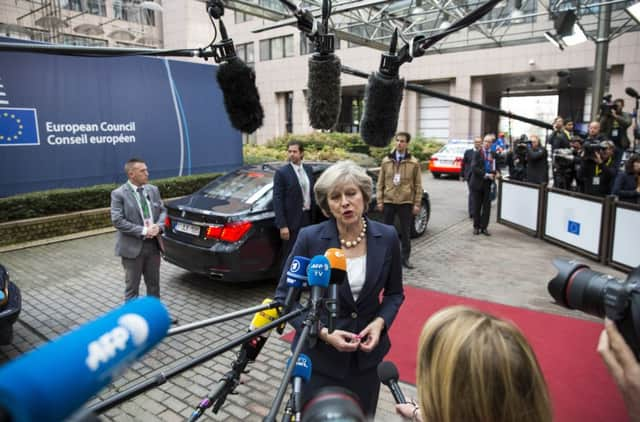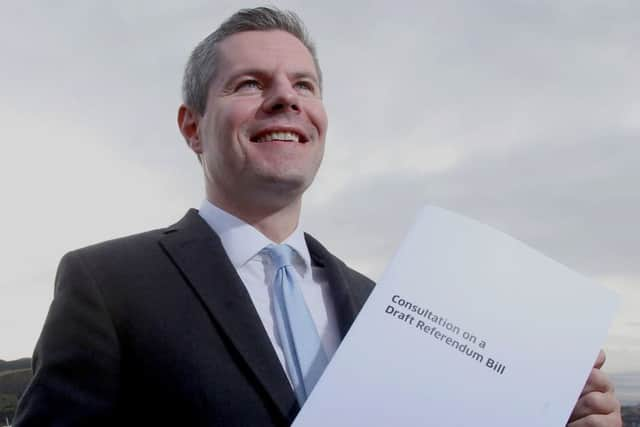The new Scottish independence referendum bill explained


A The bill unveiled by the Scottish Government proposes to ask the question: “Should Scotland be an Independent Country?” Voters will then be asked to tick one of two boxes indicating Yes or No on the ballot paper. This is the same question Scots were asked in 2014.
Q Who will “referee” the referendum campaign?
A The Electoral Commission will be charged with regulating the campaign as was the case last time. This means it is charged with ensuring that strict spending limits are adhered on the part of each side. It also has the job selecting who the lead campaigns will be if more than one candidate comes forward. The organisation is headed in Scotland by former human rights campaign chief Jenny Watson.


Q Will there be rules on spending?
Advertisement
Hide AdAdvertisement
Hide AdA Yes. Any individual or organisation who wants to spend more than £10,000 on campaigning must register as a “permitted participant” in order to make the whole process more open and transparent. The lead campaigns last time had a spending limit of £1.5m. No figure is set out for this in the current Bill, although Better Together complained it was too low last time. The No campaign did outspend the independence side in the last campaign. The combined spending on the Nationalist side was £3.12m, while the No campaign spent about £3.54m.
Q Will “purdah” rules apply?
A Yes. This is the period when both Scottish and UK government ministers are supposed to desist from making major government announcements on policy or spending which could be seen to influence the outcome of the campaign. Last time round the period was 28 days and this is being proposed again.


Q Who can vote?
A The franchise is the same as the Holyrood and Scottish local Government elections. This means 16- and 17-years-olds will again be allowed to vote unlike the EU referendum. It will also include all British citizens living in Scotland, Commonwealth citizens and people from EU countries who stay here. Military personnel serving in the UK or overseas will also be allowed to vote as they were in 2014.
Q When would it happen?
A Ms Sturgeon says the vote is likely to take place before the UK leaves the EU. That is a two-year process likely to be triggered early next year, so it looks increasingly as though the SNP is targeting a date in mid-to-late 2018. The timing is aimed at ensuring Scotland does not have to leave the EU, but can remain inside, as an independent nation, while the UK departs.
Q What happens now?
A The Bill goes out to consultation, but that is likely to be a formality. It will only come back to parliament for a vote on the issue if Nicola Sturgeon decides she has no option but to press ahead with a second referendum in the aftermath of the Brexit vote. It will certainly be passed in the Scottish Parliament with the minority SNP able to call six independence-supporting Greens to secure a Nationalist majority for the bill.
Q Will it definitely happen?
A No. The UK government has control over the constitution and could block a legal referendum. Nationalists insist this would be counter-productive and fire up anger towards Westminster. There’s also nothing to stop Holyrood pushing ahead with its own referendum. This would lack the legal clout of a vote endorsed by the UK government, although all referenda are consultative. Any move to enact independence would always be taken by government.
Q Will it mean a return of Better Together and Yes Scotland?
A Yes. There will be two “designated organisations” on either side who will head up the campaigns. These will be chosen by the Electoral Commission.
Q Who will lead the campaigns?
Advertisement
Hide AdAdvertisement
Hide AdA That remains unclear. The success of Yes Scotland in 2014, where it was widely seen to have won the campaign battle after coming from so far behind in the polls, could see a return for Blair Jenkins as campaign chief. The pro-union campaign will be less clear. Alistair Darling who headed it up last time is unlikely to fancy a return to the political frontline after two years away. Labour also blame their downfall in recent years on their perceived “alliance” with the Tories in Better Together, so it may be that a less cohesive campaign from the parties is likely. The Scotland in the Union campaign has emerged in recent months to take up the pro-UK cause and may step into the breach.
Q What’s changed since 2014?
A The Brexit vote means Scotland is poised to leave the EU despite most people (62 per cent) north of the Border voting to stay. Nationalists say this is “democratically unacceptable” and say independence may be the only way to counter this.
Q Who will win?
A Most recent polls have had both sides neck and neck with the unionists enjoying a slight lead, although the last poll for BMG suggested support for independence had dipped to just 38 per cent. However the independence campaign started on about 30 per cent last time round and had risen to 45 per cent by time of the vote, so it’s too early to say.